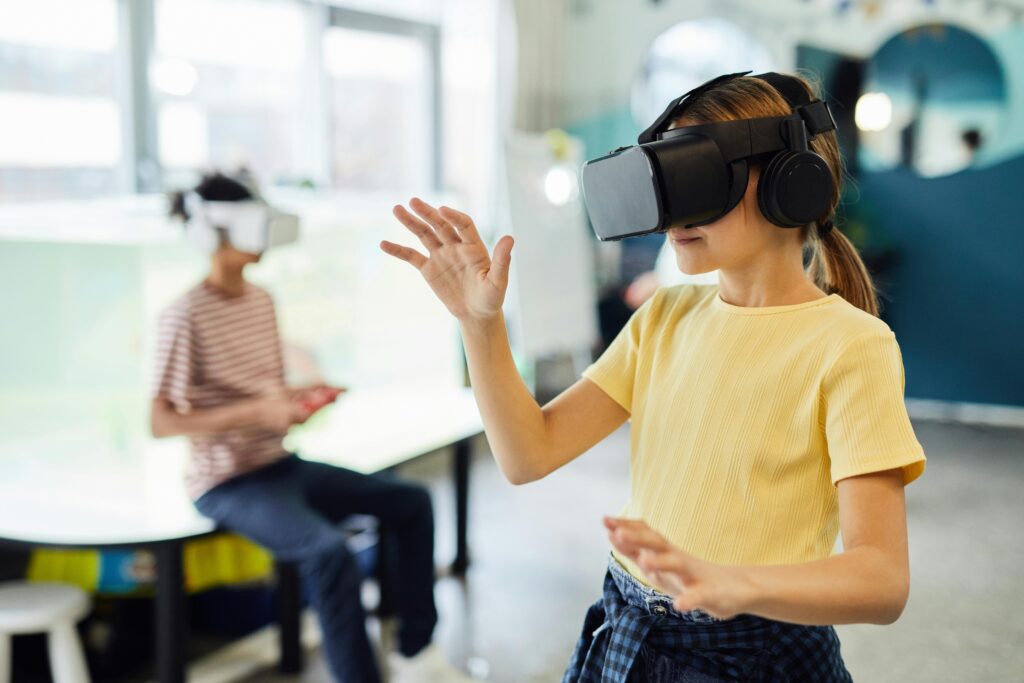Augmented Reality (AR) is one of the most accessible and widely used forms of immersive technology. Unlike Virtual Reality (VR), which takes users into an entirely digital world, AR enhances the real world by overlaying digital content such as images, sounds, and information. And because it works on devices we already use—smartphones, tablets, and increasingly, smart glasses—AR is steadily becoming a part of our daily routines.
In this post, we’ll explore how AR is integrated into everyday life, the industries that are embracing it, and how it’s transforming the way we learn, shop, work, and play.
What Is Augmented Reality (AR)?
Augmented Reality is a technology that superimposes computer-generated content onto a user’s view of the real world. This is typically done through a screen—like your phone—or wearable devices. AR recognizes physical objects or surfaces and displays digital content related to them, creating an interactive, layered experience.
Common tools used in AR include:
- Smartphones and tablets with cameras
- AR smart glasses (e.g., Microsoft HoloLens, Magic Leap, Nreal)
- AR-compatible apps like Snapchat, Instagram, IKEA Place, or Google Lens
AR in Social Media and Communication
AR has become a huge part of how we engage with social media.
- Filters and Lenses: Apps like Instagram, Snapchat, and TikTok use AR filters to add fun and creative overlays to your face or environment. These filters can change your appearance, add backgrounds, or animate your surroundings.
- Real-time Effects: You can now virtually try on makeup, clothes, or hairstyles via AR tools in beauty and fashion apps, making social media not just expressive, but also practical.
These fun applications are more than just entertainment—they’ve normalized AR in the lives of millions, setting the stage for deeper adoption in other sectors.
AR in Retail and E-Commerce
One of the most useful applications of AR is in shopping. Brands are using AR to enhance the buyer experience by helping customers visualize products before purchase.
- Virtual Try-Ons: Brands like Sephora and Warby Parker allow customers to try on makeup or glasses using their smartphone cameras. This reduces return rates and increases buyer confidence.
- AR Furniture Placement: IKEA’s AR app lets users place virtual furniture in their homes to see how it fits and looks in their space before making a purchase.
- Interactive Packaging: Some brands use AR on product packaging to show recipes, behind-the-scenes content, or instructions when scanned with a phone.
This “try-before-you-buy” approach is reshaping consumer expectations and turning shopping into an interactive experience.
AR in Education and Learning
AR makes learning more engaging, interactive, and accessible.
- Interactive Textbooks and Flashcards: When scanned with an AR app, students can see 3D models of the solar system, human anatomy, or historical artifacts.
- Language Learning: Apps like Mondly use AR to create real-world scenarios for practicing conversations.
- Museum and Campus Tours: Visitors can scan exhibits or signs to get AR-enhanced audio-visual guides or interactive elements that bring history to life.
By making abstract or distant concepts more tangible, AR significantly improves comprehension and retention in learners of all ages.
AR in Navigation and Exploration
AR is changing how we navigate the world.
- Google Maps AR: When walking in unfamiliar cities, Google Maps uses AR to place arrows and directions over real-world imagery to guide you more intuitively.
- AR Travel Guides: Point your phone at a landmark, and an app might provide historical facts, audio commentary, or reconstructed images of what the site looked like in the past.
This dynamic, real-time layer of information enhances exploration and makes getting around much easier—especially in foreign environments.
AR in Healthcare and Medicine
AR is making its way into medical practices and patient care.
- Surgical Assistance: Surgeons can use AR to see 3D visualizations of organs or tissues during procedures, helping them operate with higher precision.
- Patient Education: Doctors use AR to explain diagnoses or treatment plans more clearly, using visuals to help patients understand complex conditions.
- Physical Therapy: AR-based rehab exercises encourage patients to perform movements correctly and stay engaged through gamification.
These applications improve the accuracy of care and boost patient outcomes through clearer communication and more effective training.
Everyday AR: Smart Glasses and Future Interfaces
Smart glasses and wearable AR devices are slowly moving toward mainstream use. Companies like Meta, Apple, and Microsoft are investing in headsets that could soon replace or supplement smartphones.
- Live Translations and Subtitles
- Facial Recognition with Contextual Info
- AR Messaging and Productivity Apps
Though still in early stages, wearable AR has the potential to shift our digital lives from screen-based interaction to a fully integrated layer over the real world.
Conclusion: AR Is Here to Stay
Augmented Reality has already found its place in everyday life—often without us even realizing it. It makes our experiences richer, our decisions more informed, and our interactions more dynamic. As hardware becomes more affordable and software more intuitive, AR will become even more deeply embedded in the fabric of our day-to-day lives.
Whether you’re shopping, learning, exploring, or just having fun, AR is enhancing the way we interact with the world—one digital layer at a time.


